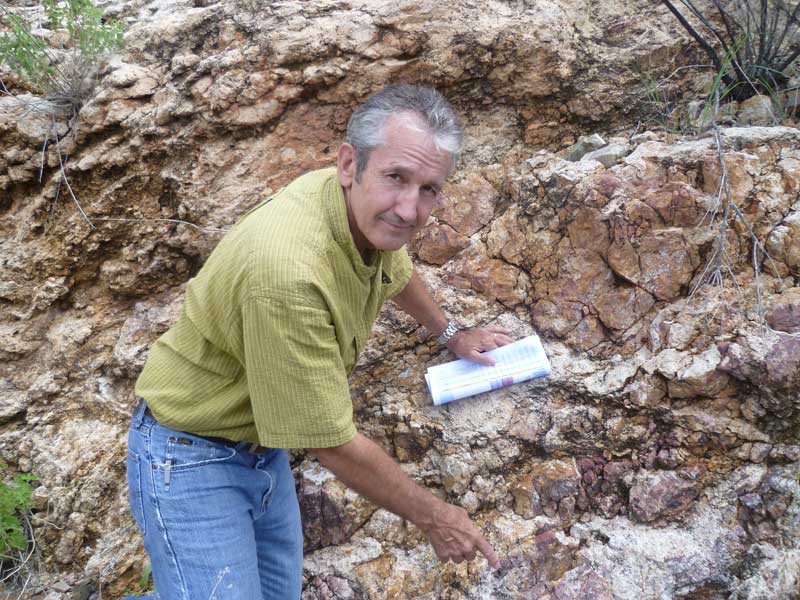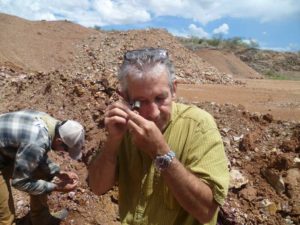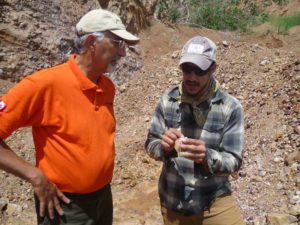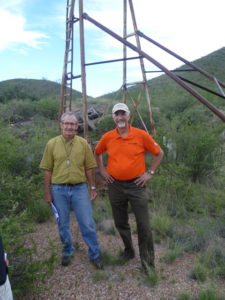Aztec eyes repeat of Arizona’s world class zinc find


When Arizona Mining Inc. [AZ-TSX] outlined 100 million tonnes of 10.4% zinc equivalent in a measured and indicated resource at its Taylor zone discovery in Arizona, it raised some eyebrows in a state that has traditionally been known for copper deposits.
“Who would have thought that one of the world’s largest zinc deposits would be found in Arizona,” said Brad Cooke, Chairman of Aztec Minerals Corp. [AZT-TSXV, AZZTF-OTCQB], a Vancouver junior which is hoping for a repeat on its own Arizona property.
Home of the Grand Canyon, and a venue for countless cowboy movies, Arizona had previously been known for copper deposits developed by the likes of Freeport-McMoRan Inc. [FCX-NYSE], Rio Tinto Plc [RIO-NYSE, ASX, LSE, RTPPF-OTCPK], BHP Billiton Ltd. [BHP-NYSE, BHPLF-OTCPK] and others.
Arizona Mining’s accomplishment was amplified when the company was recently scooped up in a $1.8 billion dollar deal by Australian company South32 Ltd. [S32-ASX, JSE, LSE, SOUHY-ADR), which has described Taylor as a “truly world class deposit.”
Now, as so often happens in the mining sector, the Taylor zone discovery and subsequent takeover of Arizona has triggered a move by other juniors to look for similar sized zinc deposits in the vicinity of the Hermosa project.
One of them is Aztec Minerals.

Backed by investors that include Coeur Mining Inc. [CDE-NYSE], with a 9.9% interest, Aztec is hoping to emulate Arizona Mining’s success on a project located near Tombstone, a Wild West town made infamous by a long history of mining and the infamous gunfight at the OK Corral in 1881.
It takes about 1.5 hours to drive from Tuscon to the property, which is 65 kilometres northeast of the Taylor deposit and close to the Mexican border.
When Resource World visited the site, Aztec was evidently maintaining a peaceful coexistence with the local tourism trade. The property is within earshot of the fake gun fights that are a key tourist attraction in downtown Tombstone.
However, any potential conflict with tourism would seem to be a long way off as Aztec is still in the early exploration stages on the Tombstone properties, which cover 163.5 hectares and host a number of historic silver mines as well as a former open pit operation known as the Contention Mine.
Aztec is led by Cooke, a Vancouver-based geologist, who is better known as founder and CEO of Endeavour Silver Corp. [EDR-TSX]. His stable of companies also includes Canarc Resources Corp. [CCM-TSX], of which he is Chairman.
The project was brought to his attention by a New York based shareholder of Endeavour, who is also invested in Vancouver-based Baroyeca Gold & Silver Inc. [BGS-TSXV, BRYGF-OTC].

Under an agreement with Baroyeca (and its U.S. subsidiaries Tombstone Gold & Silver Inc. and Tombstone Resources Inc.), Aztec can acquire a 75% interest in the properties. It agreed to earn that interest by spending $1 million on exploration, making $100,000 in cash payments and issuing one million Aztec common shares to Baroyeca over a 3-year period.
While they were taking reporters on a drive through the properties, Cooke and Aztec CEO Joey Wilkins were quick to stress the line of thinking that brought Aztec to the region.
“We are acquiring these Tombstone properties because we see an entire district with a prolific history of small scale, high grade mining and a significant lack of modern exploration to discover new orebodies,” Wilkins said.
The Tombstone Project is underlain by the same Paleozoic limestone sequence that hosts Arizona Mining’s Taylor zinc-lead deposit.
During the site visit, Wilkins was quick to point out that Taylor is predominantly a carbonate replacement deposit (CRD), which permeates downward to a depth of 3,600 ft. (1,100 m) and is composed of zinc-lead-silver-copper sulphides.
That’s well below the deepest silver mines in the Tombstone district which typically occur no more than 200 metres below surface. However, company officials are confident that the small historic high grade silver mines at Tombstone could be useful in tracking the location of mineral-controlling structures, and presumably aid the search for a CRD mineralization.

A key feature of the Tombstone properties are a warren of tunnels that were dug by old time miners who were searching for high grade silver. Aztec says historic deep drilling by a company formerly known as Santa Fe Gold, encountered narrow, but high grade CRD mineralization on the Tombstone claims.
On Monday, August 27, 24-hours after Aztec hosted the site visit, the company said it has launched a $139,000 Phase 1 exploration program at its Tombstone Project. The program will consist of structural and geological mapping, soil and rock sampling, trenching and geophysical surveying.
The aim is to better define the three styles of mineralization known to exist on the property and to identify top priority targets for drilling.
The three types of mineralization at Tombstone include:
- High grade silver-gold-lead veins cutting Cretaceous Bisbee Group clastic sediments, which hosted historic mines at the Tombstone district.
- Bulk tonnage silver-gold epithermal stock-works also cutting Bisbee Group, on which an open pit heap leach mine was developed in the 1980s.
- Potential high grade, bulk tonnage CRD deposits, which could like below the Bisbee Group in the underlying Paleozoic limestones, a geological setting similar to Arizona Mining’s Taylor deposit.
The program is being overseen Wilkins, a geologist for 30 years who has extensive experience in exploration for porphyry copper worldwide and has previously worked for Rio Tinto and its Kennecott Exploration unit.
The original silver discovery in the Tombstone district dates back to 1877.
Historic production from 1878 to 1939 is reported at 32 million ounces of silver, 240,000 ounces of gold, 65 million pounds of lead, 2.4 million pounds of copper and 1.1 million pounds of zinc.
Some of the richest production in the Tombstone district came from the Grand Central and Contention Mines, which are both located on the Baroyeca properties. Sporadic underground mining continued until 1980, when open pit heap leach mining commenced at the Contention Pit. It operated until 1985, producing 1.1 million ounces of silver and 20,000 ounces of gold.
“We believe the Baroyeca properties have substantial untapped potential, especially below the water table around 600 feet deep, because that is where the oxide ores stopped and the sulfide ores could start,” said Wilkins.
Aztec is primarily interested in discovering new zones of epithermal and CRD mineralization because they typically form much larger mineralized bodies then anything that has been found at Tombstone so far.
However, if that strategy doesn’t pan out, a property of Tombstone’s size would seem to offer other opportunities, including production from more open pits.
“We will take a systematic approach to exploring the properties by digitizing all historic work, evaluating available data, evaluating available data on small historic gold-silver deposits, and completing surface work, such as structural and alteration mapping, geochemical sampling and geophysical surveying followed by drilling,” the company has said.
Aztec Minerals was launched in May 2, 2017 following an IPO priced at 35 cents a share. Initially the offering consisted of 10 million units (plus another 1.5 million over-allotment units), each comprised of one common share and a one-half of a transferrable common share purchase warrant. Each full warrant allows the holder to purchase an additional share at an exercise price of 50 cents for a period of 2-years after the closing date of the IPO.
The shares traded at 24 cents on August 29, 2018 in a 52-week range of 38 cents and 14.5 cents.
Aztec was spun out to create a public vehicle that could be used to fund exploration at the Cervantes property in Mexico, which remains the junior’s flagship asset. Cervantes is a porphyry gold-copper-molybdenum prospect which is located in Sonora, 160 kilometres east of Hermosillo. It is being explored under an option agreement with Kootenay Silver Inc. [KTN-TSXV, KOOYF-OTC] that allows Aztec to acquire a 100% interest in the property in two stages.
Cervantes is located in the Laramide porphyry belt approximately 265 kilometres southeast of the huge Cananea porphyry copper-molybdenum mine of IMMSA and 55 kilometres west of Alamos Gold Inc.’s [AGI-TSX, NYSE] Mulatos epithermal gold mine.
A NI-43-101-compliant technical report was commissioned and completed in late 2016. It recommended that Aztec spend US$1.8 million on a two phase exploration program that included 2,000 metres of diamond drilling and airborne magnetics.
Aztec recently reported positive results from rock chip sampling along drill roads at its California porphyry gold-copper prospect on the Cervantes property. Highlights include 0.47 g/t gold over 222.0 m.
The company said rock chip sample results from five of seven sample lines confirm the previous highly anomalous soil sample results and extensive porphyry-type gold mineralization intersected in the Phase 1 drill program.
Aztec’s $182,000 Phase 2 exploration program is focused on better defining additional drill targets on the recently expanded property, which now covers 3,649 hectares.
As for Tombstone, Wilkins said he is convinced that the company can come up with compelling exploration targets. However, the company likely won’t consider drilling until next year. If that is the case, it will like fund future drilling with the proceeds of a private placement or bring in a partner.
